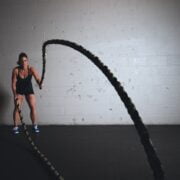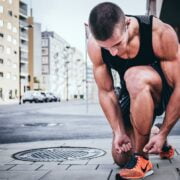
Get Stronger and Sculpt Your Legs with this Effective Leg Day Workout PDF
Welcome to our blog post on the importance of leg day for overall fitness. In this article, we will discuss why leg day is crucial for your fitness routine and provide you with a Leg Day Workout PDF that you can download and follow along. Whether you are a beginner or an advanced athlete, incorporating leg day into your workout routine can have numerous benefits for your overall fitness and athletic performance.
Key Takeaways
- Leg day is an essential part of overall fitness and should not be skipped.
- Warm-up exercises are crucial to prepare your legs for the workout and prevent injury.
- Compound exercises like squats and lunges are effective for building stronger legs.
- Isolation exercises like calf raises and leg extensions can help sculpt specific leg muscles.
- Plyometric exercises like jump squats can improve leg power and endurance.
The Importance of Leg Day for Overall Fitness
Leg day is often overlooked by many individuals who focus primarily on upper body exercises. However, neglecting your lower body can lead to imbalances in your physique and hinder your overall fitness progress. Leg day is important for several reasons.
Firstly, leg day helps to improve balance and stability. Strong legs are essential for maintaining balance during various activities, such as walking, running, and even standing. By strengthening the muscles in your legs, you can improve your overall balance and reduce the risk of falls or injuries.
Secondly, leg day is crucial for improving posture. Weak leg muscles can lead to poor posture, which can result in back pain and other musculoskeletal issues. By incorporating leg exercises into your workout routine, you can strengthen the muscles that support your spine and improve your posture.
Lastly, leg day is essential for enhancing athletic performance. Whether you are a runner, a cyclist, or a basketball player, strong legs are vital for optimal performance in any sport. Leg exercises such as squats and lunges can help to increase power, speed, and agility, allowing you to perform at your best.
Warm-Up Exercises to Prepare Your Legs for the Workout
Before diving into your leg day workout, it is crucial to warm up your muscles properly. Warming up helps to increase blood flow to the muscles, improve flexibility, and reduce the risk of injury. Here are some examples of warm-up exercises that you can incorporate into your leg day routine:
1. Jogging or brisk walking: Start your warm-up with a few minutes of light cardio to get your heart rate up and increase blood flow to your muscles.
2. Leg swings: Stand next to a wall or a sturdy object and swing one leg forward and backward, keeping it straight. Repeat for 10-15 swings on each leg.
3. Hip circles: Stand with your feet shoulder-width apart and place your hands on your hips. Slowly rotate your hips in a circular motion, first clockwise and then counterclockwise. Repeat for 10-15 circles in each direction.
4. Bodyweight squats: Stand with your feet shoulder-width apart and lower yourself into a squat position, keeping your chest up and your knees in line with your toes. Repeat for 10-15 squats.
Remember to perform each warm-up exercise slowly and with control. Gradually increase the intensity of the exercises as you warm up to prepare your legs for the workout ahead.
Compound Exercises for Building Stronger Legs
| Exercise | Muscles Worked | Equipment Needed | Difficulty Level |
|---|---|---|---|
| Squats | Quadriceps, Hamstrings, Glutes, Calves, Core | Barbell, Squat Rack | Intermediate to Advanced |
| Deadlifts | Hamstrings, Glutes, Lower Back, Quads, Core | Barbell, Weight Plates | Intermediate to Advanced |
| Lunges | Quadriceps, Hamstrings, Glutes, Calves, Core | Dumbbells, Barbell, Smith Machine | Beginner to Intermediate |
| Step-ups | Quadriceps, Hamstrings, Glutes, Calves, Core | Bench, Dumbbells | Beginner to Intermediate |
| Bulgarian Split Squats | Quadriceps, Hamstrings, Glutes, Calves, Core | Dumbbells, Bench | Intermediate |
Compound exercises are multi-joint movements that engage multiple muscle groups at once. These exercises are highly effective for building strength and muscle mass in the legs. Here are some examples of compound exercises that you can incorporate into your leg day workout:
1. Squats: Squats are one of the most effective compound exercises for building stronger legs. Start by standing with your feet shoulder-width apart, lower yourself into a squat position by bending at the knees and hips, and then return to the starting position. Repeat for 3-4 sets of 8-12 reps.
2. Lunges: Lunges target the quadriceps, hamstrings, and glutes. Start by standing with your feet hip-width apart, take a step forward with one leg, lower yourself into a lunge position by bending both knees, and then push back up to the starting position. Repeat for 3-4 sets of 8-12 reps on each leg.
3. Deadlifts: Deadlifts primarily target the hamstrings, glutes, and lower back. Start by standing with your feet hip-width apart, bend at the hips and knees to lower yourself down while keeping your back straight, and then return to the starting position by driving through your heels. Repeat for 3-4 sets of 8-12 reps.
Compound exercises are highly effective for building overall leg strength and muscle mass. Incorporating these exercises into your leg day routine will help you achieve your fitness goals faster.
Isolation Exercises for Sculpting Your Leg Muscles
While compound exercises are great for building overall leg strength, isolation exercises target specific leg muscles and help to sculpt and define them. Here are some examples of isolation exercises that you can incorporate into your leg day workout:
1. Calf raises: Calf raises target the calf muscles (gastrocnemius and soleus). Start by standing with your feet hip-width apart, raise yourself up onto your toes, hold for a second, and then lower yourself back down. Repeat for 3-4 sets of 12-15 reps.
2. Leg extensions: Leg extensions primarily target the quadriceps. Start by sitting on a leg extension machine with your knees bent at a 90-degree angle, extend your legs until they are straight, hold for a second, and then lower them back down. Repeat for 3-4 sets of 8-12 reps.
3. Hamstring curls: Hamstring curls target the hamstrings. Start by lying face down on a hamstring curl machine with your ankles hooked under the padded bar, curl your legs up towards your glutes, hold for a second, and then lower them back down. Repeat for 3-4 sets of 8-12 reps.
Isolation exercises are great for targeting specific leg muscles and adding definition to your legs. Incorporate these exercises into your leg day routine to achieve a well-rounded leg workout.
Plyometric Exercises to Boost Leg Power and Endurance
Plyometric exercises, also known as jump training, are explosive movements that help to improve leg power, speed, and endurance. These exercises involve rapid stretching and contracting of the muscles, which helps to develop explosive strength. Here are some examples of plyometric exercises that you can incorporate into your leg day workout:
1. Box jumps: Start by standing in front of a sturdy box or platform, lower yourself into a quarter squat position, and then explode upwards, jumping onto the box and landing softly with both feet. Step back down and repeat for 3-4 sets of 8-12 reps.
2. Jump squats: Start by standing with your feet shoulder-width apart, lower yourself into a squat position, and then explode upwards, jumping as high as you can. Land softly and immediately go into the next repetition. Repeat for 3-4 sets of 8-12 reps.
3. Lateral bounds: Start by standing with your feet hip-width apart, take a big leap to the side, landing softly on one foot, and then immediately leap back to the other side. Repeat for 3-4 sets of 8-12 reps on each side.
Plyometric exercises are intense and require a high level of strength and coordination. Start with lower intensity variations and gradually increase the difficulty as you become more comfortable with the movements.
Tips for Proper Form and Technique During Leg Day Workout
Maintaining proper form and technique during your leg day workout is crucial for maximizing results and preventing injuries. Here are some tips to help you maintain proper form:
1. Keep your core engaged: Engaging your core muscles helps to stabilize your spine and maintain proper alignment during leg exercises. Focus on pulling your belly button in towards your spine and maintaining a neutral spine throughout the movements.
2. Keep your knees in line with your toes: When performing exercises such as squats and lunges, make sure to keep your knees in line with your toes to prevent excessive stress on the knee joints. Avoid letting your knees collapse inward or extend too far past your toes.
3. Use a full range of motion: When performing leg exercises, aim to use a full range of motion to engage the muscles fully. This means lowering yourself as far as you can comfortably go during squats and lunges, and fully extending your legs during leg extensions and hamstring curls.
4. Breathe properly: Remember to breathe throughout your leg day workout. Inhale during the eccentric (lowering) phase of the exercise and exhale during the concentric (lifting) phase. This helps to provide oxygen to your muscles and maintain proper form.
5. Start with lighter weights: If you are new to leg day workouts or trying out a new exercise, start with lighter weights or bodyweight exercises to ensure proper form and technique. Gradually increase the weight as you become more comfortable with the movements.
Proper form and technique are essential for preventing injuries and maximizing the effectiveness of your leg day workout. Take the time to learn and practice proper form for each exercise to ensure optimal results.
How to Modify the Workout for Different Fitness Levels
The leg day workout can be modified to suit different fitness levels, whether you are a beginner or an advanced athlete. Here are some examples of modifications that can be made:
Beginners:
– Start with bodyweight exercises before progressing to weighted exercises.
– Perform fewer sets and reps, focusing on proper form and technique.
– Use lighter weights or resistance bands for added support.
– Take longer rest periods between sets to allow for recovery.
Advanced athletes:
– Increase the weight or resistance for each exercise.
– Perform more sets and reps to increase the intensity.
– Incorporate advanced variations of exercises, such as pistol squats or single-leg deadlifts.
– Shorten rest periods between sets to increase the challenge.
It is important to listen to your body and progress at a pace that is suitable for your fitness level. Gradually increase the intensity and difficulty of your leg day workout as you become stronger and more comfortable with the exercises.
Cool-Down Stretches to Prevent Injury and Promote Recovery
After completing your leg day workout, it is crucial to cool down and stretch your muscles to prevent injury and promote recovery. Here are some examples of cool-down stretches that you can incorporate into your routine:
1. Standing quad stretch: Stand with your feet hip-width apart, bend one knee, and grab your ankle with the corresponding hand. Pull your heel towards your glutes until you feel a stretch in the front of your thigh. Hold for 30 seconds on each leg.
2. Seated hamstring stretch: Sit on the floor with one leg extended in front of you and the other leg bent with the sole of your foot against your inner thigh. Reach forward towards your toes, keeping your back straight, until you feel a stretch in the back of your thigh. Hold for 30 seconds on each leg.
3. Standing calf stretch: Stand facing a wall or sturdy object, place both hands against the wall at shoulder height, and step one foot back while keeping both heels on the ground. Lean forward until you feel a stretch in the calf of the back leg. Hold for 30 seconds on each leg.
Cooling down and stretching after your leg day workout helps to reduce muscle soreness, improve flexibility, and promote recovery. Take the time to stretch all major muscle groups in your legs to ensure a well-rounded cool-down routine.
Sample Leg Day Workout Plan for Beginners and Advanced Athletes
Here is a sample leg day workout plan that you can follow, whether you are a beginner or an advanced athlete. Remember to warm up properly before starting the workout and cool down and stretch afterwards.
Beginners:
1. Bodyweight squats: 3 sets of 10 reps
2. Walking lunges: 3 sets of 10 reps on each leg
3. Calf raises: 3 sets of 12 reps
4. Seated leg extensions: 3 sets of 10 reps
5. Seated hamstring curls: 3 sets of 10 reps
Advanced athletes:
1. Barbell squats: 4 sets of 8 reps
2. Bulgarian split squats: 4 sets of 8 reps on each leg
3. Box jumps: 4 sets of 8 reps
4. Romanian deadlifts: 4 sets of 8 reps
5. Standing calf raises: 4 sets of 12 reps
Remember to adjust the weight or resistance according to your fitness level and take rest periods between sets as needed. Focus on maintaining proper form and technique throughout the workout.
Incorporating leg day into your fitness routine is essential for overall fitness and athletic performance. Leg exercises help to improve balance, posture, and strength, while also enhancing athletic performance in various sports. By following a well-rounded leg day workout plan that includes compound exercises, isolation exercises, and plyometric exercises, you can achieve stronger and more sculpted legs.
Remember to warm up properly before your leg day workout to prevent injuries and improve performance. Focus on maintaining proper form and technique during exercises to maximize results and prevent injuries. Modify the workout according to your fitness level, whether you are a beginner or an advanced athlete.
After completing your leg day workout, cool down and stretch your muscles to promote recovery and prevent muscle soreness. Take the time to stretch all major muscle groups in your legs to ensure a well-rounded cool-down routine.
Download our Leg Day Workout PDF and try the sample workout plan provided. Remember to listen to your body, progress at your own pace, and enjoy the benefits of a strong and sculpted lower body.
Looking for a comprehensive leg day workout routine? Look no further! We’ve got you covered with our Leg Day Workout PDF. But if you’re interested in taking your leg day routine to the next level, you might want to check out this article on Wave Magnets. They offer a unique approach to strength training using magnetic resistance technology. Discover how their innovative equipment can help you maximize your leg day gains and take your workouts to new heights. Don’t miss out on this exciting opportunity – click here to learn more about Wave Magnets and revolutionize your leg day routine!
FAQs
What is a leg day workout?
A leg day workout is a type of exercise routine that focuses on strengthening and toning the muscles in the legs, including the quadriceps, hamstrings, glutes, and calves.
What are the benefits of a leg day workout?
A leg day workout can help improve overall lower body strength, increase muscle mass, improve balance and stability, and enhance athletic performance.
What exercises are typically included in a leg day workout?
Exercises that are typically included in a leg day workout include squats, lunges, deadlifts, leg presses, calf raises, and leg extensions.
How often should I do a leg day workout?
The frequency of leg day workouts depends on individual fitness goals and training schedules. However, it is generally recommended to do a leg day workout at least once a week.
What should I eat before and after a leg day workout?
Before a leg day workout, it is recommended to eat a meal that is high in carbohydrates and protein to provide energy and fuel for the workout. After a leg day workout, it is recommended to eat a meal that is high in protein to aid in muscle recovery and repair.
Can a leg day workout help with weight loss?
Yes, a leg day workout can help with weight loss by increasing muscle mass and boosting metabolism, which can lead to increased calorie burn and fat loss.

















